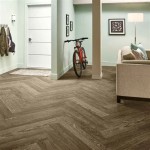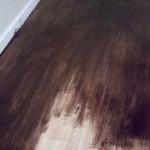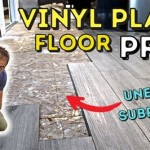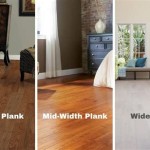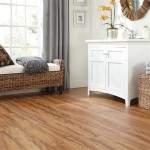How Durable Is Cork Flooring With Dogs?
Cork flooring, prized for its sustainability, comfort underfoot, and unique aesthetic, has gained popularity as an alternative to traditional flooring options like hardwood, laminate, and tile. However, a common concern among pet owners, particularly those with dogs, is the durability of cork flooring in the face of canine activity. This article will explore the characteristics of cork that influence its durability, examine specific challenges posed by dogs, and provide insights into how to mitigate potential damage and maintain cork flooring in a dog-friendly household.
Cork is derived from the bark of the cork oak tree, primarily found in the Mediterranean region. The bark is harvested without harming the tree, making it a renewable resource. After harvesting, the bark is processed, granulated, and compressed into sheets or tiles that are used for flooring. The cell structure of cork is its defining feature, comprised of millions of tiny air-filled cells per cubic inch. This unique structure lends cork its inherent properties, including resilience, thermal insulation, sound absorption, and a degree of water resistance.
The durability of cork flooring is a multifaceted issue, dependent on several factors. Density plays a crucial role. Higher density cork is generally more resilient to indentation and scratching. The thickness of the cork also contributes; thicker planks or tiles will withstand more wear and tear than thinner options. The finish applied to the cork flooring is another critical consideration. A robust finish, such as polyurethane or a ceramic-reinforced coating, provides a protective layer against scratches, stains, and moisture penetration. Finally, installation quality and maintenance practices significantly influence the longevity of cork flooring, regardless of the presence of dogs.
Understanding the Challenges Dogs Pose to Cork Flooring
Dogs, with their active lifestyles and inherent behaviors, present specific challenges to any type of flooring. These challenges are amplified with a relatively soft material like cork. The primary concerns include:
*Scratching:
Dog claws, especially those that are not regularly trimmed, can easily scratch the surface of cork flooring. The severity of the scratches depends on the dog's size, weight, activity level, and the type of cork flooring installed. Large, active dogs are likely to cause more noticeable scratches than smaller, more sedentary breeds. *Indentation:
While cork is resilient, heavy dogs or repeated impact from dropped toys or energetic play can cause indentations in the floor. The density of the cork and the thickness of the flooring will determine its resistance to permanent indentation. *Accidents and Staining:
Urine and other pet accidents can stain and damage cork flooring if not cleaned up immediately. The acidic nature of urine can erode the finish and penetrate the porous cork material, leading to discoloration and odor. The type of finish applied to the cork directly impacts its resistance to staining. *Moisture Damage:
Cork is water-resistant, but not waterproof. Prolonged exposure to moisture, such as from spilled water bowls or leaky plumbing, can cause swelling and warping of the cork. Dogs tracking in water or mud can exacerbate this issue. *Chewing:
Puppies and some adult dogs have a tendency to chew on things, and the edges of cork flooring, particularly in corners or near doorways, can become targets for chewing. This can cause significant damage and require costly repairs.Strategies for Protecting Cork Flooring From Dogs
While the challenges posed by dogs are real, several strategies can be employed to minimize damage and extend the life of cork flooring in a dog-friendly home. Implementing these preventative measures can significantly improve the long-term performance of the flooring.
*Choose High-Density Cork Flooring:
Opting for high-density cork flooring is the first line of defense against damage. Denser cork is more resistant to indentation and scratching. Investigate the density rating of the cork product before purchasing. Aim for a density of at least 450 kg/m3 for improved durability. *Select a Durable Finish:
The finish on cork flooring acts as a protective barrier. Choose a finish that is specifically designed for high-traffic areas and is resistant to scratches, stains, and moisture. Polyurethane finishes are a common choice, but ceramic-reinforced finishes offer enhanced durability and scratch resistance. Ensure the finish is applied correctly and according to the manufacturer's instructions. *Maintain Consistent Claw Trimming:
Regular claw trimming is essential to prevent scratches on any type of flooring, including cork. Trim your dog's claws every two to three weeks, or as needed, to keep them short and blunt. Consider using a nail grinder instead of clippers to achieve a smoother, less sharp edge. *Use Area Rugs and Runners:
Strategically placing area rugs and runners in high-traffic areas, such as hallways, entryways, and near furniture, can provide an extra layer of protection against scratches and indentations. Choose rugs with non-slip backings to prevent them from sliding and causing accidents. *Clean Up Accidents Immediately:
Promptly cleaning up any pet accidents is crucial to prevent staining and moisture damage. Use a mild detergent and warm water to clean the affected area, and be sure to thoroughly dry the floor afterward. Avoid using harsh chemicals or abrasive cleaners, as these can damage the finish. *Provide Ample Exercise and Chew Toys:
Ensuring your dog gets enough exercise can help reduce their tendency to scratch or chew due to boredom or pent-up energy. Provide plenty of chew toys to satisfy their natural chewing instincts and redirect their attention away from the flooring. *Train Your Dog:
Basic obedience training can help prevent destructive behaviors that could damage the flooring. Teach your dog commands such as "leave it" and "off" to discourage them from chewing or jumping on furniture. *Protect High-Risk Areas:
Consider using furniture pads under heavy furniture to prevent indentations. Place mats under water bowls and food bowls to catch spills and prevent moisture damage. Use baby gates or pet confinement systems to restrict your dog's access to certain areas of the house if necessary. *Regular Maintenance:
Consistent preventative measures and maintenance habits are essential. Regular sweeping or vacuuming removes dirt and debris that can scratch the floor. Periodic mopping with a pH-neutral cleaner keeps the floor clean and preserves the finish. Reapplying the finish as needed, typically every few years, can help maintain the floor's protective layer and extend its lifespan.Repairing and Refinishing Cork Flooring
Despite taking preventative measures, some wear and tear is inevitable, especially in a home with dogs. Minor scratches and dents can often be repaired using cork filler or a specialized cork repair kit. For more significant damage, such as deep scratches or stains, refinishing the cork flooring may be necessary.
Refinishing involves sanding down the existing finish and applying a new coat of sealant. This process can restore the floor's original appearance and provide a fresh layer of protection. However, it is important to note that cork flooring can only be sanded a limited number of times, as the cork layer is relatively thin. Consult with a professional flooring contractor to determine if refinishing is the appropriate solution for your specific situation.
The success of repairing or refinishing cork flooring depends on the extent of the damage and the type of finish previously applied. Minor scratches and dents can often be addressed without professional assistance, using readily available DIY repair kits. However, extensive damage or the need for a specialized finish application should be handled by experienced professionals to ensure a high-quality result.
Selecting appropriate cleaning products and using proper mopping techniques are crucial for maintaining the appearance and durability of cork flooring. Always use a pH-neutral cleaner specifically designed for cork flooring. Avoid using harsh chemicals, abrasive cleaners, or steam mops, as these can damage the finish and the cork material. When mopping, use a damp mop rather than a soaking wet one to prevent moisture from seeping into the seams and causing damage. Regular cleaning and proper maintenance will help prolong the life of your cork flooring and keep it looking its best, even in a home with dogs.

Cork Flooring For Dogs A Durable And Pet Friendly Solution Portuguese Treasures

Beautiful Dog Proof Flooring With Forna Dogguard Cancork

Beautiful Dog Proof Flooring With Forna Dogguard Cancork

Cork Flooring Durable With Dogs Icork Floor

What Is The Best Flooring For Your Dogs Part 2

Is Cork Flooring Durable With Dogs Icork Floor

Beautiful Dog Proof Flooring With Forna Dogguard Cancork

Is Cork Flooring Durable With Dogs Icork Floor

Beautiful Dog Proof Flooring With Forna Dogguard Cancork

Helios Composite Deck Tiles 6 Slat Outdoor Flooring
Related Posts



